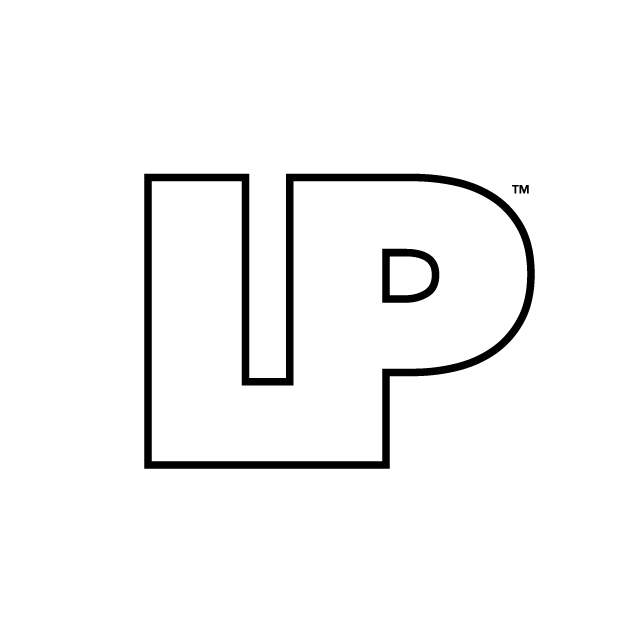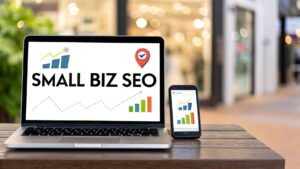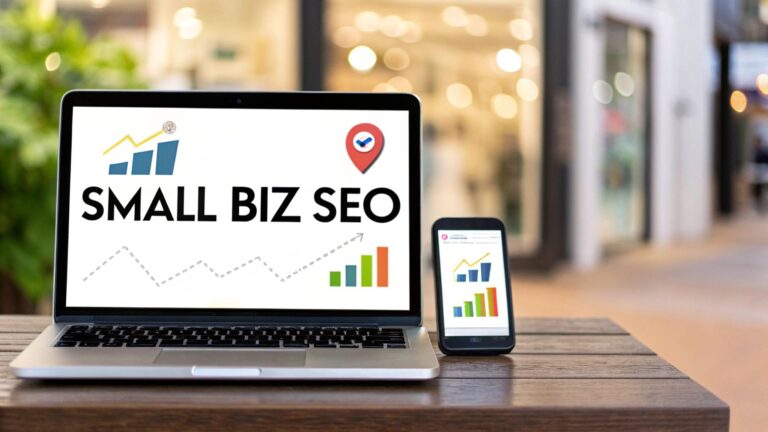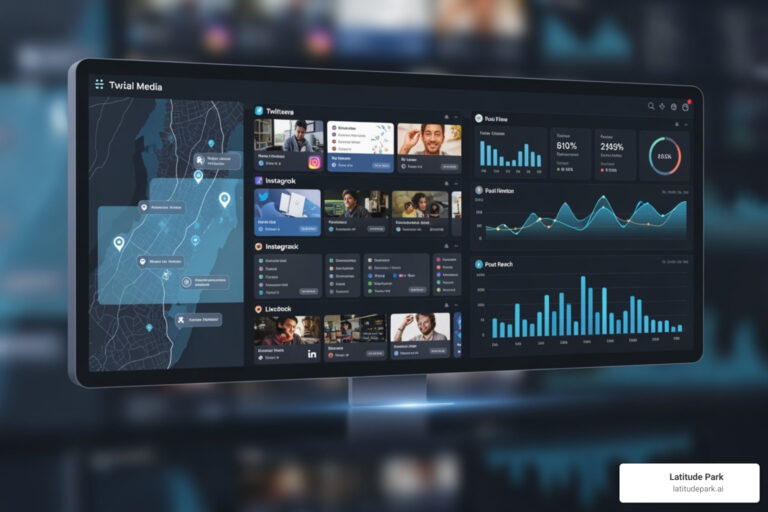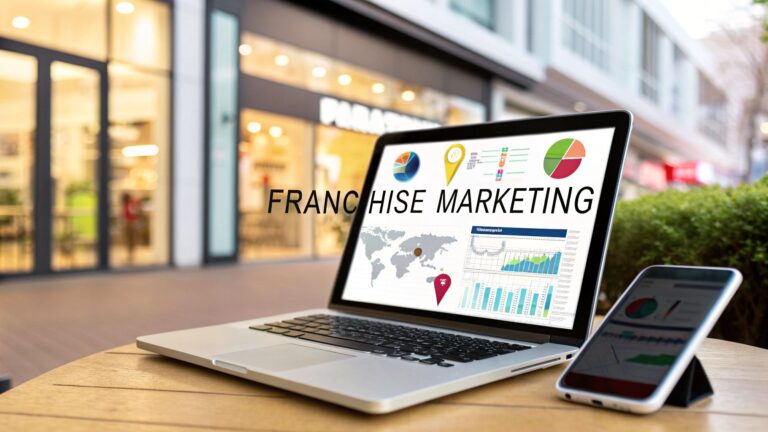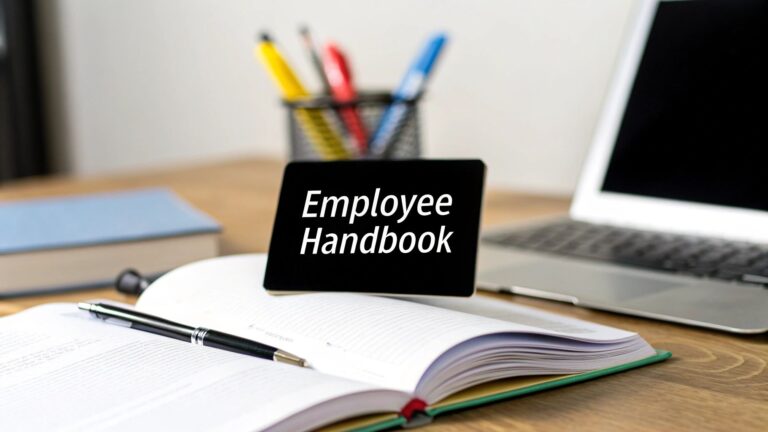For small businesses, SEO is all about showing up when your customers need you the most. It’s the art and science of making your website more visible in search results, connecting you with people actively looking for exactly what you sell. Forget the complex technical jargon; this is about becoming a trusted online resource for your local community.
It's a game-changer for growth, letting you punch well above your weight and compete with bigger companies without needing a massive ad budget. For example, a local, family-owned hardware store can use SEO to rank higher than a big-box chain for a search like "best paint for kitchen cabinets" by creating a detailed, helpful blog post on the topic.
Why SEO Is Your Small Business Superpower
If your website is your digital storefront, think of SEO as the giant, brightly lit sign on the street corner pointing everyone your way. It’s hands-down the most powerful tool a small business has for getting discovered by customers who are already searching for you. Without it, you’re basically invisible online, hoping for word-of-mouth to carry you.
But this isn't just about getting clicks; it's about getting the right kind of clicks. SEO connects you with high-intent customers at the very moment they need you. For instance, a click from someone searching "24-hour emergency AC repair" is far more valuable than a hundred clicks from "how does an air conditioner work?"
Turning Searches into Customers
Imagine you own a small plumbing company in Denver. A homeowner’s pipe just burst, and they’re frantically searching "emergency plumber near me" on their phone. Because you’ve nailed your local SEO, your website pops up at the top of the results. In an instant, you've solved their urgent problem and won a new customer.
That’s the magic of SEO for small businesses—it turns a digital search into a real-world solution. You're not pushing ads on people; you're pulling in customers who are already raising their hands for help. The insight here is that SEO captures existing demand, while paid ads often try to create it.
The Three Pillars of Small Business SEO
To build a rock-solid online presence, your strategy needs to stand on three core pillars. Understanding how these pieces fit together is the first step toward creating a plan that gets real results. Let's break them down.
| SEO Pillar | Primary Goal | Practical Example |
|---|---|---|
| Technical SEO | Ensure search engines can easily crawl, index, and understand your website. | Compressing the large images on your homepage so your site loads in under 3 seconds, even on a mobile connection. |
| On-Page SEO | Create relevant, helpful content that answers your customers' questions. | A local bakery writing a blog post titled "How to Choose the Perfect Wedding Cake" that includes flavor options, sizing guides, and pricing. |
| Off-Page SEO | Build your website's authority and trustworthiness across the internet. | A local roofer gets a link back to their website from a well-respected home improvement blogger who featured their work in a case study. |
Each pillar supports the others, working together to create a strong foundation that will steadily grow your online visibility month after month.
For a small business, strong SEO isn't an expense; it's an asset that generates value over time. Every piece of optimized content you create and every local citation you build acts like a small, digital salesperson working for you 24/7.
Ultimately, investing in SEO means you're building a sustainable channel to bring in new customers. It lets you compete on the quality of your work and the depth of your expertise, not just the size of your marketing budget. This levels the playing field, making SEO an indispensable superpower for any small business looking to grow for the long haul.
Mastering Local SEO to Dominate Your Area
For any small business with a physical storefront or a defined service area, winning the local game is everything. When your neighbors search for "coffee shop near me" or "best roofer in Austin," you absolutely need to be the business Google trusts enough to show them.
This is the real power of local SEO, and it all starts with your Google Business Profile. Treat it like your most valuable digital asset, because it is.
Think of your Google Business Profile (GBP) as your digital storefront. It’s often the very first interaction a potential customer has with your business, popping up in Google Maps and the highly-coveted "Local Pack" at the top of the search results. A well-tended profile doesn't just sit there—it actively drives customers right to your door.
Your Google Business Profile Is Your Digital Storefront
Getting this right is surprisingly straightforward. The first step is to simply claim and verify your profile. This hands you the keys, giving you full control over how your business shows up online. A complete and accurate profile sends a powerful signal to Google that you're legitimate, active, and trustworthy.
This screenshot shows the main dashboard for a Google Business Profile—your central hub for managing your entire local presence.

From here, you can update vital details, respond to customer reviews, and see exactly how people are finding you. It’s an indispensable tool for local growth.
Optimizing Every Detail for Maximum Impact
An empty or half-finished profile is a huge missed opportunity. To truly get a handle on local SEO, you need to meticulously fill out every single section with information that's not just accurate, but compelling. This goes way beyond just your business name.
-
Write a Compelling Description: Don't just list what you do. Tell a story. What makes your business special? Practical example: Instead of "We fix cars," try "Your trusted, family-owned auto repair shop in Springfield for over 20 years, specializing in honest diagnostics and fair pricing for all domestic and foreign vehicles."
-
Choose the Right Categories: Pick a primary category that best fits your business (e.g., "Italian Restaurant"). Then, add secondary categories to capture everything else you offer (e.g., "Pizza Delivery," "Catering," "Wine Bar"). This helps Google understand the full scope of your services.
-
Upload High-Quality Photos: Show people what you're all about! A restaurant needs vibrant photos of its dishes. A contractor should have plenty of before-and-after shots from recent jobs. Practical insight: Regularly add new photos (e.g., one per week) to signal to Google that your business is active.
The Power of Customer Reviews and Consistent NAP
Reviews are the lifeblood of local SEO. They act as social proof, building trust with potential customers and sending incredibly strong ranking signals to Google. Make it a habit to actively encourage your happy customers to leave reviews.
And just as importantly, respond to all of them—the good and the bad. A thoughtful, professional response to a negative review can often win over more future customers than a dozen five-star ratings. Example Response: "Hi Jane, we're so sorry to hear your experience wasn't up to our standards. We take this feedback seriously and would appreciate the chance to make it right. Please contact our manager, Tom, at [phone number]."
Equally critical is maintaining consistent NAP (Name, Address, Phone Number) information all across the web.
Your NAP information needs to be absolutely identical everywhere it appears online. That means your website, local directories like Yelp, and your Chamber of Commerce listing should all match perfectly. Even a tiny inconsistency, like writing "St." instead of "Street," can confuse search engines and ding your local rankings.
This infographic shows just how important local keyword research is for figuring out what your customers are looking for in your specific area.

When you analyze this data, you can fine-tune your GBP and website content to match the exact phrases your local customers are using.
The value of this hyper-local focus is backed by some pretty powerful data. Statistics show that businesses appearing in Google’s Local Pack can see a 40% higher click-through rate than their competitors. When you consider that 46% of all Google searches have local intent, optimizing for your area isn't just a good idea—it's essential for survival and growth.
Ultimately, local SEO is all about connecting online searches to real-world visits and sales. You can explore our guide on how local SEO services dramatically benefit your business to learn more about turning these digital interactions into loyal, local customers.
Finding the Right Keywords Your Customers Use
Keyword research might sound like a bunch of technical jargon, but it’s really just about learning to speak your customers' language. This is the bedrock of any solid SEO for small businesses strategy because it plugs you directly into what your audience is trying to solve, right now.
Think about it this way: you own a local bakery and you're incredibly proud of your "multi-grain artisan loaf." That’s what you call it. But your customers? They might just be searching for "healthy whole wheat bread." Nail that difference, and you've unlocked the secret to getting found online. It’s all about shifting your perspective from how you see your business to how your customers are looking for it.
This isn't a guessing game, and it’s definitely not about stuffing your pages with random terms. It’s a discovery process—uncovering the exact phrases people type into Google when they need exactly what you offer. This insight is what lets you create content that feels like a perfect answer to their question at the exact moment they ask it.

Uncovering What Customers Are Actually Searching For
To find these golden phrases, you don't need expensive tools right out of the gate. Think of the tools you already have access to as your own personal customer listening devices, helping you tune into conversations that are already happening.
A fantastic place to start is Google's own search bar. Seriously. Start typing a service you offer, like "landscaping services," and just watch the autocomplete suggestions that pop up. These aren't guesses; they are real, popular searches people are making every single day.
You’ll immediately see variations that get much more specific, revealing what people actually need:
- "Landscaping services for small yards"
- "Affordable landscaping services near me"
- "Drought-tolerant landscaping services"
These aren't just keywords. They're windows into your customers' minds, showing you exactly what they want. Each one is far more powerful than a generic term like "landscaping."
Understanding the "Why" Behind the Search
Okay, so identifying keywords is one thing. But the real game-changer is understanding search intent—the "why" behind someone’s search. This is what separates the tire-kickers from the ready-to-buy customers.
Someone searching for "how to fix a leaky faucet" is in learning mode. But the person searching for "emergency plumber in Brooklyn" has a completely different, much more urgent need. They're ready to pick up the phone and hire someone. Now.
Understanding search intent helps you create the right kind of content for the right person at the right time. Your goal is to match your website pages to the user's specific need, whether it’s to learn, compare, or buy.
If you want to go a bit deeper on how search engines figure all this out, it’s worth understanding the difference between semantic search versus keyword search. It’s key to creating content that truly connects.
Finding Your Keyword Sweet Spot
For a small business, the perfect keywords have two crucial traits: they're dead-on relevant to what you do, and you have a realistic shot at ranking for them. Trying to rank for a term like "shoes" is a fool's errand. But "handmade leather boots in Austin"? That’s a specific, targeted phrase you can absolutely own.
These are what we call long-tail keywords. They’re longer, more descriptive phrases that, while getting fewer searches individually, add up to a ton of traffic from highly motivated customers.
Here’s a practical example for a local dog groomer:
| Broad Keyword (High Competition) | Long-Tail Keyword (Your Sweet Spot) | Search Intent |
|---|---|---|
| Dog grooming | Mobile dog grooming for anxious dogs | Customer has a specific problem (anxious pet) and needs a specialized solution. |
| Pet services | Hypoallergenic dog grooming services | Customer is looking for a solution for a pet with allergies. High purchase intent. |
| Dog wash | Weekend dog grooming appointments | Customer needs a service that fits their specific schedule. |
Focusing on these long-tail keywords is just a smarter way to play the game for small businesses. You get to sidestep the brutal competition from the big guys and connect directly with the people most likely to become your customers. For more strategies on this, check out our guide on how to choose good keywords that are irresistible to your target market. By listening closely to the language of your customers, you build a foundation for SEO that actually works.
Optimizing Your Website for Search and People
Alright, you've done the heavy lifting and figured out what your customers are actually typing into Google. So, what’s next? Where do all those valuable keywords go?
This is exactly where on-page SEO enters the picture. It’s all about fine-tuning individual pages on your website so they rank higher in search results and, more importantly, attract the right kind of traffic.
Think of each page on your site as having one specific job. Your goal is to make that job crystal clear to both search engines and the real people visiting your site. This isn't about cramming keywords into every nook and cranny; it's about crafting genuinely helpful content that naturally answers your customers' questions.
Making Every Page Count
Every single important page on your website—from your homepage to your service pages and blog posts—deserves this kind of attention. The idea is to strategically place your main keywords in the key spots where search engines expect to find them. Doing this sends a strong signal to Google about what each page is about, helping it show up in the right searches.
A well-optimized page is easy for anyone to understand at a glance. For a small business, getting these on-page fundamentals right is one of the most direct and powerful ways to boost your online visibility.
On-page SEO is like setting up your physical store. You wouldn't just toss products on the floor, would you? You’d organize them on shelves, create clear aisle signs, and hang a welcoming sign on the door. It all works together to create a great experience.
On-Page SEO Checklist for Small Businesses
To keep things simple, let's walk through the most critical on-page elements. By running through this checklist for every key page, you can make sure your website is pulling its weight and actively attracting new customers.
This table breaks down the core components you need to get right.
| On-Page Element | What It Is | Practical Example |
|---|---|---|
| Title Tag | The clickable headline you see in Google search results. | "Custom Wedding Cakes in Boston | Anna's Bakery" (Keyword first, under 60 characters). |
| Meta Description | The short summary that appears under your title in search results. | "Create your dream wedding cake with Anna's Bakery. Award-winning designs & delicious flavors. Get a free tasting in our Boston studio!" (Compelling, includes a call-to-action). |
| Header Tags (H1, H2) | The main headlines and subheadings within your content. | H1: "Custom Wedding Cakes in Boston" H2: "Our Most Popular Cake Flavors" H2: "Wedding Cake Pricing & Packages" |
| Image Alt Text | A text description of an image for search engines and visually impaired users. | "Three-tier wedding cake with white frosting and fresh roses, designed by Anna's Bakery in Boston." |
| URL Structure | The web address for a specific page. | annasbakery.com/wedding-cakes (Short, descriptive, and includes the main keyword). |
Applying these principles consistently creates a clear roadmap for Google, making it much easier for the search engine to understand, trust, and rank your content. To dive deeper into this, check out our guide on effective SEO techniques to improve your website's search ranking.
From Keywords to High-Quality Content
While all the technical bits are important, the real heart of great on-page SEO for small businesses is the content itself. Your pages need to be more than just optimized—they need to be the absolute best answer to a potential customer’s problem.
Let's say you're a local HVAC contractor targeting "air conditioner repair in Phoenix." A truly great service page wouldn't just repeat that phrase over and over. It would deliver real value.
-
Answer Common Questions: Add a small FAQ section addressing things like, "How often should my AC be serviced?" or "What are the warning signs my AC is about to fail?" This shows you know your stuff.
-
Show, Don't Just Tell: Include photos of your team on the job or sprinkle in a few glowing testimonials from happy customers. This builds trust in an instant.
-
Be Clear and Direct: Use simple language and clear headings. A visitor should be able to scan your page and find exactly what they're looking for in seconds. Practical example: Instead of a long paragraph, use a bulleted list: "Our AC Repair Services Include: 24/7 Emergency Calls, Freon Recharging, Thermostat Repair, and Full System Diagnostics."
At the end of the day, your goal is to create a resource that is genuinely useful. When you shift your focus to helping the user, you naturally create content that search engines love to rank. This customer-first approach is the most sustainable way to win at SEO for the long haul.
Building Trust with Off-Page SEO Strategies
If on-page SEO is all about making your website crystal clear and helpful to visitors, then off-page SEO is about building your reputation across the wider internet. It answers one critical question for search engines: "Is this website trustworthy and authoritative?" Getting this right is a huge piece of the puzzle for any successful SEO for small businesses strategy.
Think of it like getting a great recommendation in the real world. If a well-respected local business owner tells someone you're the absolute best at what you do, that endorsement carries serious weight. Off-page SEO works the exact same way online, and the primary currency of trust is the backlink.
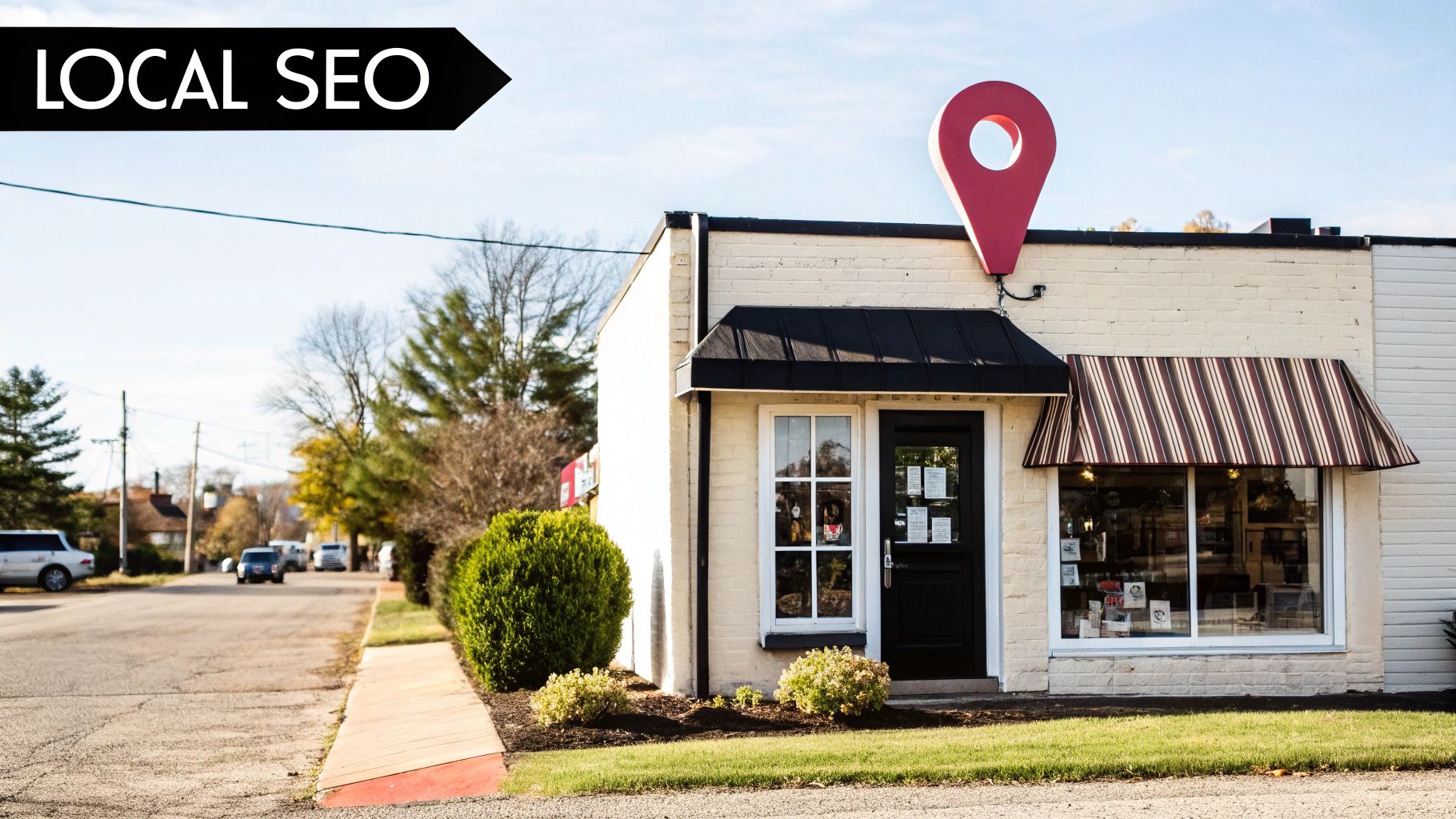
Backlinks as Votes of Confidence
So, what is a backlink? It's simply a link from another website back to yours. You can think of each one as a "vote of confidence." When another site links to you, they're essentially vouching for your content, telling their own audience that your website is a valuable resource worth checking out.
But here’s the thing: not all votes are created equal. A single, high-quality backlink from a trusted, relevant source is far more powerful than a hundred links from spammy, low-quality websites. For example, a link from your city's Chamber of Commerce website is infinitely more valuable than a link from a random, unrelated blog.
Practical Link-Building for Small Businesses
For a small business owner, the whole idea of "link building" can sound pretty intimidating. The good news is you don't need a massive budget or a dedicated team to get fantastic results. The key is to lean into what makes you unique: your local community and your specific area of expertise.
Here are a few achievable strategies that work wonders:
- Sponsor a Local Event: Getting behind a local youth sports team, a charity 5K, or a community festival almost always earns you a link from their website. This is a high-authority, locally relevant link that Google absolutely loves to see.
- Create a Helpful Local Guide: Write a blog post like "The Top 5 Dog-Friendly Patios in Austin" or "A Weekend Guide to Our Neighborhood." Local bloggers and news sites are constantly on the lookout for great content to share with their readers.
- Partner with Other Local Businesses: Team up with a non-competing business on a promotion. For instance, a local gym and a health food store could co-author a guide to healthy living and link to each other's sites.
The best off-page SEO strategies feel less like marketing and more like genuine community engagement. By becoming a valuable part of your local ecosystem, you naturally earn the kinds of backlinks that build lasting authority.
Beyond Backlinks: Building Your Brand
While backlinks are the undisputed star of the off-page SEO show, other brand-building activities also send positive signals to search engines. These actions show that you are a real, active, and respected business in your field.
Public relations is a powerful off-page strategy for earning media mentions and building brand authority. Discover tips for effectively getting on PR lists to boost your brand opportunities.
Other simple yet effective tactics include:
- Guest Appearances on Podcasts: Find local or industry-specific podcasts and offer to share your expertise. Most hosts will include a link back to your website in the show notes.
- Getting Featured in Local Media: A feature in a local newspaper or community blog can send a flood of relevant traffic your way and provide a seriously powerful backlink.
- Encouraging Social Media Mentions: While social media links don't carry the same SEO weight as traditional backlinks, brand mentions and shares build social proof and show that people are talking about you.
Ultimately, building off-page authority is a long-term game. It’s all about forging real relationships and becoming a trusted name in your field—both online and off.
Measuring Your SEO Success with Simple Metrics
Putting time and effort into your SEO is great, but how do you actually know if it’s working? You don't need to become a data scientist to figure it out. By focusing on just a handful of key metrics, you can get a clear picture of what's driving real growth for your small business.
The goal isn’t to get lost in spreadsheets. It's about pulling out simple insights that help you make smarter decisions. Free tools like Google Analytics 4 and Google Search Console are all you need to track what truly matters. This is about measuring progress so you can double down on the strategies that actually bring customers through the door.
Tracking Your Organic Traffic Growth
The most direct measure of your SEO success is a jump in organic traffic—these are the visitors who find your website through a search engine without clicking on an ad. Think of this as the digital equivalent of foot traffic; more visitors simply mean more opportunities.
You can easily track this in Google Analytics 4. Just look for the "Traffic acquisition" report and filter by "Organic Search." Seeing a steady, upward trend over a few months is a fantastic sign that your efforts are paying off and more people are discovering your business. Practical insight: Don't panic over daily dips; look at the month-over-month or quarter-over-quarter trend for a true measure of progress.
Identifying Your Ranking Keywords
Knowing which keywords you rank for is like listening in on what your customers are asking Google. This is where Google Search Console shines. It shows you the exact search queries people used to find your site, how often you appeared (impressions), and how many people actually clicked through (clicks).
For example, a local bakery might discover they're getting a ton of traffic from "vegan birthday cakes near me." That's a powerful insight. It tells them they should create more content around that specific topic or even feature it more prominently on their homepage.
Don’t just focus on high-volume keywords. Pay close attention to the long-tail keywords that are driving qualified traffic. A single click from a search like "emergency roof leak repair" is often far more valuable than dozens of clicks from a vague term like "roofer."
This data helps you understand what content is truly resonating with your audience and where your best opportunities are hiding.
Measuring Direct Business Leads
For most small businesses, the ultimate goal of SEO isn't just clicks—it's to make the phone ring or bring people to your front door. Your Google Business Profile provides the metrics that connect your online activity to real-world business.
Right inside your GBP dashboard, you can see crucial data points that prove your SEO is working:
- Phone Calls: Track how many people clicked the "Call" button directly from your profile in the search results.
- Direction Requests: See how many potential customers asked Google Maps for directions to your physical location.
- Website Clicks: Measure how many users visited your site after finding you in local search or on the map.
These are not vanity metrics; they represent tangible leads and potential sales. By monitoring these simple numbers, you can directly measure the return on your investment in SEO for small businesses and see how your online visibility is actively growing your bottom line.
Frequently Asked Questions About Small Business SEO
Diving into SEO for the first time always brings up a ton of practical questions. Let's cut through the noise and get you some direct answers to the things small business owners really want to know. This will help you set the right expectations for the journey ahead.
How Long Does SEO Take to Work for a Small Business?
This is the big one, isn't it? The honest answer is that SEO is a long game, not an overnight fix. While you might see some early movement in local rankings within a few weeks—especially with a perfectly optimized Google Business Profile—truly significant, business-changing results typically take 6 to 12 months to materialize.
Think of it like planting a tree. You have to water it, make sure it gets sunlight, and give it time to grow strong roots before it provides any real shade. The timeline really depends on how competitive your industry is, your specific location, and how consistently you put in the work. For example, a plumber in a small town might see results faster than a lawyer in New York City.
Can I Do SEO Myself or Do I Need an Agency?
Absolutely! Many small business owners can get fantastic results handling their own SEO, especially when it comes to local search. Just by following the steps in this guide, you can make a huge impact on your own. A practical starting point is to dedicate 2-3 hours per week to optimizing your Google Business Profile and writing one helpful blog post per month.
So, when does an agency make sense? You should consider hiring help if you’re in a super-competitive market or you simply don't have the time to dedicate to it. A great strategy is to start with the basics yourself and then bring in a pro once your business starts to grow and you need to scale your efforts.
The most important part of SEO for a local business is almost always Local SEO. This begins with a fully optimized Google Business Profile, which often serves as a customer's first interaction with your business online.
What Is the Most Important Part of SEO for a Local Business?
For nearly any local business—whether you have a storefront or a service area—Local SEO is the most critical component. And the heart of Local SEO is your Google Business Profile (GBP).
Your GBP is often the very first thing a potential customer sees when they search for what you offer. Making sure it’s complete, accurate, and active with fresh reviews can drive phone calls, website clicks, and foot traffic more effectively than almost any other SEO task. A rock-solid GBP is the true foundation of a winning SEO for small businesses strategy.
Ready to turn search engine visibility into real business growth? At Latitude Park, we specialize in creating powerful SEO strategies that get franchises and small businesses noticed. Schedule a free consultation with us today!
